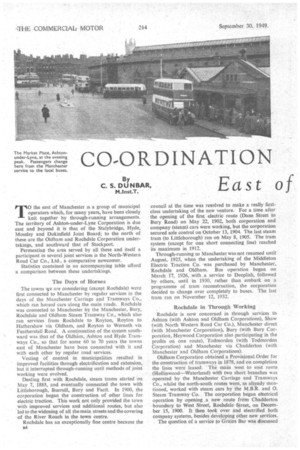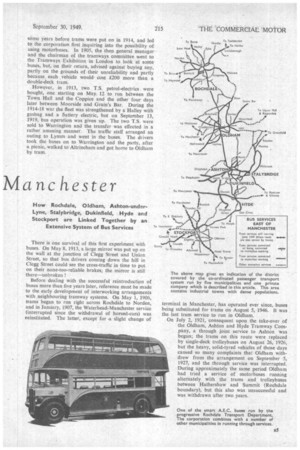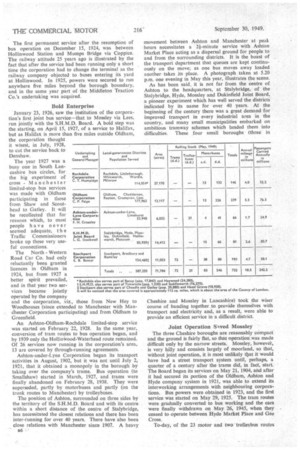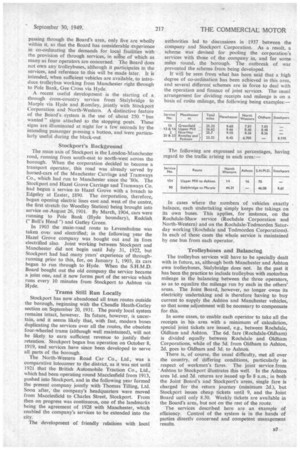CO-ORDINATION
Page 38

Page 39

Page 40

Page 41

If you've noticed an error in this article please click here to report it so we can fix it.
East of
Manchester
By C. S. DUNBAR,
Minst.T.
TO the east of Manchester is a group of municipal operators which, for many years, have been closely knit together by through-running arrangements. The territory of Ashton-under-Lyne Corporation is due east and beyond it is that of the Stalybridge, Hyde, Mossley and Dukinfield Joint Board; to the north of these are the Oldham and Rochdale Corporation undertakings, and southward that of Stockport.
Permeating the area served by all these and itself a participant in several joint services is the North-Western Road Car Co., Ltd., a comparative newcomer.
Statistics contained in an accompanying table afford a comparison between these undertakings.
The Days of Horses The towns we are considering (except Rochdale) were first connected to Manchester by regular services in the days of the Manchester Carriage and Tramways Co., which ran horsed cars along the main roads. Rochdale was connected to Manchester by the Manchester, Bury, Rochdale and Oldham Steam Tramway Co., which also ran services from Rochdale to Royton, Royton to Hathershaw via Oldham, and Royton to Werneth via Featherstall Road. A continuation of the system southward was that of the Oldham, Ashton and Hyde Tramways Co., so that for some 60 to 70 years the towns east of Manchester have been connected with it and with each other by regular road services.
Vesting of control in municipalities resulted in improved facilities through electrification and extension, but it interrupted through-running until methods of joint working were evolved.
Dealing first with Rochdale, steam trams started on May 7, 1883, and eventually connected the town with Littleborough, Buersill, Bury and Facit. In 1900, the corporation began the construction of other lines for electric traction. This work not only provided the town with improved services and additional routes, but also led to the widening of all the main streets and the covering of the River Roach in the town centre.
Rochdale has an exceptionally fine centre because the council at the time was resolved to make a really firstclass undertaking of the new venture. For a time after the opening of the first electric route (Dane Street to Bury Road) on May 22, 1902, both corporation and company (steam) cars were working, but the corporation secured sole control on October 13, 1904. The last steam tram (to Littleborough) ran on May 8, 1905. The tram system (except for one short connecting line) reached its maximum in 1912.
Through-running to Manchester was not resumed until August, 1925, when the undertaking of the Middleton Electric Traction Co. was purchased by Manchester, Rochdale and Oldham. Bus operation began on March f 7, 1926, with a service to Deeplish, followed by others, until in 1930, rather than embark on a programme of tram reconstruction, the corporation decided to change over completely to buses. The last tram ran on November 12, 1931
Rochdale in Through Working Rochdale is now concerned in through services to Ashton (with Ashton and Oldham Corporations), Shaw (with North Western Road Car Co.), Manchester direct (with Manchester Corporation), Bury (with Bury Corporation, Heywood Corporation also participating in the profits on one route), Todmorden (with Todmorden Corporation) and Manchester via Chadderton (with Manchester and Oldham Corporations).
Oldham Corporation obtained a Provisional Order for the construction of tramways in 1878, and on completion the lines were leased. 'The main west to east route (HolIinwood—Waterhead) with two short branches was operated by the Manchester Carriage and Tramways Co., whilst the north-south routes were, as already mentioned, worked with steam cars by the M.B.k. and 0. Steam Tramway Co. The corporation began electrical operation by opening a new route from Chadderton boundary to West Street, Rochdale Street, on December 15, 1900. It then took over and electrified both company systems, besides developing other new services.
The question of a service to Grains Bar was discussed
some years before trams were put on in 1914, and led to the corporation first inquiring into the possibility of using motorbuses. In 1905, the then general manager and the chairman of the tramways committee went to the Tramways Exhibition in London to look at some buses, but, on their return, advised against buying any, partly on the grounds of their unreliability and partly because each vehicle would cost £200 more than a double-deck tram.
However, in 1913, two T.S. petrol-electrics were bought, one starting on May, 12 to run between the Town Hall and the Coppice and the other four days later between Moorside and Grain's Bar. During the 1914-18 war the fleet was strengthened by a Halley with gasbag and a 6attery electric, but on September 13, 1919, bus operation was given up. The two T.S. were sold to Warrington and the transfer was effected in a rather amusing manner. The traffic staff arranged an outing to Lymm and went in the buses. The drivers took the buses on to Warrington and the party, after a picnic, walked to Altrincham and got home to Oldham by tram.
There is one survival of this first experiment with buses. On May 8, 1913, a large mirror was put up on the wall at the junction of Clegg Street and Union Street, so that bus drivers coming down the hill in Clegg Street could see the cross-traffic in time to put on their none-too-reliable brakes; the mirror is still there—unbroken !
Before dealing with the successful reintroduction of buses more than five years later, reference must be made to the early development of interworking arrangements with neighbouring tramway systems. On May 1, 1906, trams began to run right across Rochdale to Norden, and in January, 1907, the Waterhead-Manchcster service (interrupted since the withdrawal of horsed-cars) was reinstituted. The latter, except for -a slight change of terminal in Manchester, has operated ever since, buses being substituted for trams on August 5, 1946. It was the last tram service to run in Oldham.
On July 2, 1921, consequent upon the take-over of the Oldham, Ashton and Hyde Tramway Company, a through joint service to Ashton was begun; the trams on this route were replaced by single-deck trolleybuses on August 26, 1926, but the heavy, solid-tyred vehicles of those days caused so many complaints that Oldham withdrew from the arrangement on September 5, 1927, and the through service was interrupted. During approximately the same period Oldham had tried a service of motorbuses running alternately with the trams and trolleybuses between Hathershaw and Summit (Rochdale boundary), but this also was unsuccessful and was withdrawn after two years. The first permanent service after the resumption of bus operation on December 15, 1924, was between Hollinwood Station and Mumps Bridge via Coppice. The railway attitude 25 years ago is illustrated by the fact that after the service had been running only a short time the corporation had to change the terminal as the railway company objected to buses entering its yard at Hollinwood. In 1925, powers were secured to run anywhere five miles beyond the borough boundary, and in the same year part of the Middleton Traction Co.'s undertaking was acquired.
Bold Enterprise
January 23, 1926, saw the institution of the corporation's first joint bus service—that to Mossley via Lees,
The year 1927 was a busy one in South Lancashire bus circles, for the big experiment of cross Manchester limited-stop bus services was made with Oldham participating in those from Shaw and Scouthead to Gatley. It will be recollected that for reasons which, to most people have never seemed adequate, t-h e Traffic Commissioners broke up these very useful connections.
The North Western Road Car Co. had only reluctantly been granted licences in Oldham in 1924, but from 1927 a better spirit prevailed, and in that year two services became jointly operated by the company and the corporation, viz., those from New Hey to Woodhouses (since extended to Manchester with ManChester Corporation participating) and from Oldham to G reenfield.
An Ashton-Oldham-Rochdale limited-stop service was started on February 22, 1928. In the same year, conversion of tram routes to bus operation began, and by 1939 only the Hollinwood-Waterhead route remained. Of 26 services now running in the corporation's area, 13 are covered by through-running agreements.
Ashton-under-Lyne Corporation began its transport activities in August, 1902, but it was not until July 2, 1921, that it obtained a monopoly in the borough by taking over the company's trams. Bus operation (to Smallshaw) started in March, 1927, and trams were finally abandoned on February 28, 1938. They were superseded, partly by motorbuses and partly (on the trunk routes to Manchester) by trolleybuses.
The position of Ashton, surrounded on three sides by the territory of the S.H.M.D. Board and with its centre within a short distance of the centre of Stalybridge, has necessitated the closest relations and there. has been inter-running for over 40 years. There have also been close relations with Manchester since 1907. A heavy
Stockport Corporation E. R. Baxter Stockport, Bredbury and Romi ley
Totals .. .. 587,7_55 Rochdale also serves part of Battu, (pop. 17,840) and Heywood (24,380).
movement between Ashton and Manchester at pea' hours necessitates a 2i-minute service with Ashton Market Place acting as a dispersal ground for people to and from the surrounding districts. It is the boast of the transport department that queues are kept continuously on the move; as one bus moves away loaded another takes its place. A photograph taken at 5.20 p.m. one evening in May this year, illustrates the scene. As has been said, it is not far from the centre of Ashton to the headquarters, at Stalybridge, of the Stalybridge, Hyde, Mossley and Dukinfield Joint Board, a pioneer experiment which has well served the districts indicated by its name for over 40 years. At the beginning of the century there was a great demand for improved transport in every industrial area in the country, and many small municipalities embarked on ambitious tramway schemes which landed them into difficulties. These four small boroughs (three in Cheshire and Mossley in Lancashire) took the wiser course of banding together to provide themselves with transport and electricity and, as a result, were able to provide an efficient service in a difficult district.
Joint Operation Swed Mossley
The three Cheshire boroughs are reasonably compact and the ground is fairly flat, so that operation was made difficult only by the narrow streets. Mossley, howevei, is very hilly and consists largely of moorland, so that, without joint operation, it is most unlikely ttiat it would have had a street transport system until, perhaps, a quarter of a century after the trams did, in fact, start. The Board began its services on May 21, 1904, and after it had secured its portion of the Oldham, Ashton and Hyde company system in 1921, was able to extend its interworking arrangements with neighbouring corporalions. Bus powers were obtained in 1923, and the first service was started on May 29, 1925. The tram routes were gradually converted to bus working and the cars were finally withdrawn on May 26, 1945, when they ceased to operate between Hyde Market Place and Gee Cross.
To-day, of the 23 motor and two trollevbus routes
passing through the Board's area, only five are wholly within it, so that the Board has considerable experience in co-ordinating the demands for local facilities with the provision of through services, in sane of which as many as four operators are concerned. The Board does not own any trolleybuses, although it participates in the services, and reference to this will be made later. It is intended, when sufficient'vehicles are available, to introduce trolleybus working from Manchester right through to Pole Bank, Gee Cross via Hyde.
A recent useful development is the starting of a through cross-country service from' Stalybridge to Marple via Hyde and Romiley, jointly with Stockport Corporation and North-Western. A distinctive feature of the Board's system is the use of about 250 "bus wanted" signs attached to the stopping posts. These signs are illuminated at night for a few seconds by the intending passenger pi essing a button, and were particularly useful during the black-out.
• Stockport's Background The main axis of Stockport is the London-Manchester road, running from south-east to north-west across the borough. When the corporation decided to become a transport operator, this road was already served by horsed-cars of the Manchester Carriage and Tramways Co., which had run to Manchester since the '80s. The Stockport and Hazel Grove Carriage and Tramways Co. had begun a service to Hazel Grove with a branch to Edgeley at Easter, 1890. The corporation, therefore, began opening electric lines east and west of the centre, the first stretch (to Woodley Station) being brought into service on August 26, 1901. By March, 1904, cars were running to Pole Bank (Hyde boundary), Reddish (" Bull's Head ") and Gatley Green.
In 1903 the main-road route to Levenshulme was taken over and electrified; in the following year the Hazel Grove company was bought out and its lines electrified also. Joint working between Stockport and Manchester did not begin until July 31, 1922, but Stockport had had many years' experience of throughrunning prior to this, for, on January 1, 1903, its cars began to run through to Hyde. When the S.H.M.D. Board bought out the old company the service became a joint one, and it now forms part of the service which runs every 10 minutes from Stockport to Ashton via Hyde.
Trams Still Run Locally Stockport has now abandoned all tram routes outside the borough, beginning with the Cheadle Heath-Gatley section on September 20, 1931. The purely local system remains intact, however. Its future, however, is uncertain, and it seems likely that, with fast, modern buses duplicating the services over all the routes, the obsolete four-wheeled trams (although well maintained), will not be likely to earn sufficient revenue to justify their retention. Stockport began bus operation on October 8, 1919, and services have since been developed to serve all parts of the borough.
The North-Western Road Car Co., Ltd., was a comparative latecomer to the district, as it was not until 1921 that the British Automobile Traction Co., Ltd., which had been operating round Macclesfield from .1913, pushed into Stockport, and in the following year formed the present company jointly with Thomas Tilling, Ltd. Soon after, the company's headquarters were moved from Macclesfield to Charles Street, Stockport. From then on progress was continuous, one of the landmarks being the agreement of 1928 with Manchester, which enabled the company's services to be extended into the city.
The development of friendly relations with local
authorities led to discussions in 1937 between the company and Stockport Corporation. As a result, a scheme was devised for pooling the corporation's services with those of the company in, and for some miles round, the borough. The outbreak of war prevented the scheme from being developed.
ir will be seen from what has been said that a high degree of co-ordination has been achieved in this area, and several different schemes are in force to deal with the operation and finance of joint services. The usual arrangement for dividing receipts and mileage is on a basis of ro6te mileage, the following being examples:—
In cases where the numbers of vehicles exactly balance, each undertaking simply keeps the takings on its own buses. This applies, for instance, on the Rochdale-Shaw service (Rochdale Corporation and North-Western) and on the Rochdale-Todmorden Saturday working '(Rochdale and Todmorden Corporations). In each of these cases the whole service is maintained by one bus from each operator.
Trolleybuses and Balancing The trolleybus services will have to be specially dealt with in future, as, although both Manchester and Ashton own trolleybuses, Stalybridge does not. In the past it has been the practice to include trolleybus with motorbus mileage in the balancing between the three operators, so as to equalize the mileage run by each in the others' areas. The Joint Board, however, no longer owns its electricity undertaking and is therefore having to buy current to supply the Ashton and Manchester vehicles, so that some adjustment will be necessary to compensate for this.
In some cases, to enable each operator to take all the receipts in his area with a minimum of calculation, special joint tickets are issued, e.g., between Rochdale, Oldham and Ashton. The 6d. fare (Rochdale-Oldham) is divided equally between Rochdale and Oldham Corporations, while of the 5d. from Oldham to Ashton, 2d. goes to Oldham and 3d. to Ashton.
There is, of course, the usual difficulty, met all over the country, of 'differing conditions, particularly in respect of workmen's fares. The joint service from 'Ashton to Stockport illustrates this well. In the Ashton area 1d. and 2d. returns are issued up to 8 a.m.; in both the Joint Board's and Stockport's areas, single fare is charged for the return journey (minimum 2d.), but Stockport issues cheap tickets until 9, and the Joint Board until only 8.30. Weekly tickets are available in the Board's area, but not on the rest of the route. The services described here are an example of efficiency. Control of the system is in the hands of parties directly concerned and competent management results.




















































































